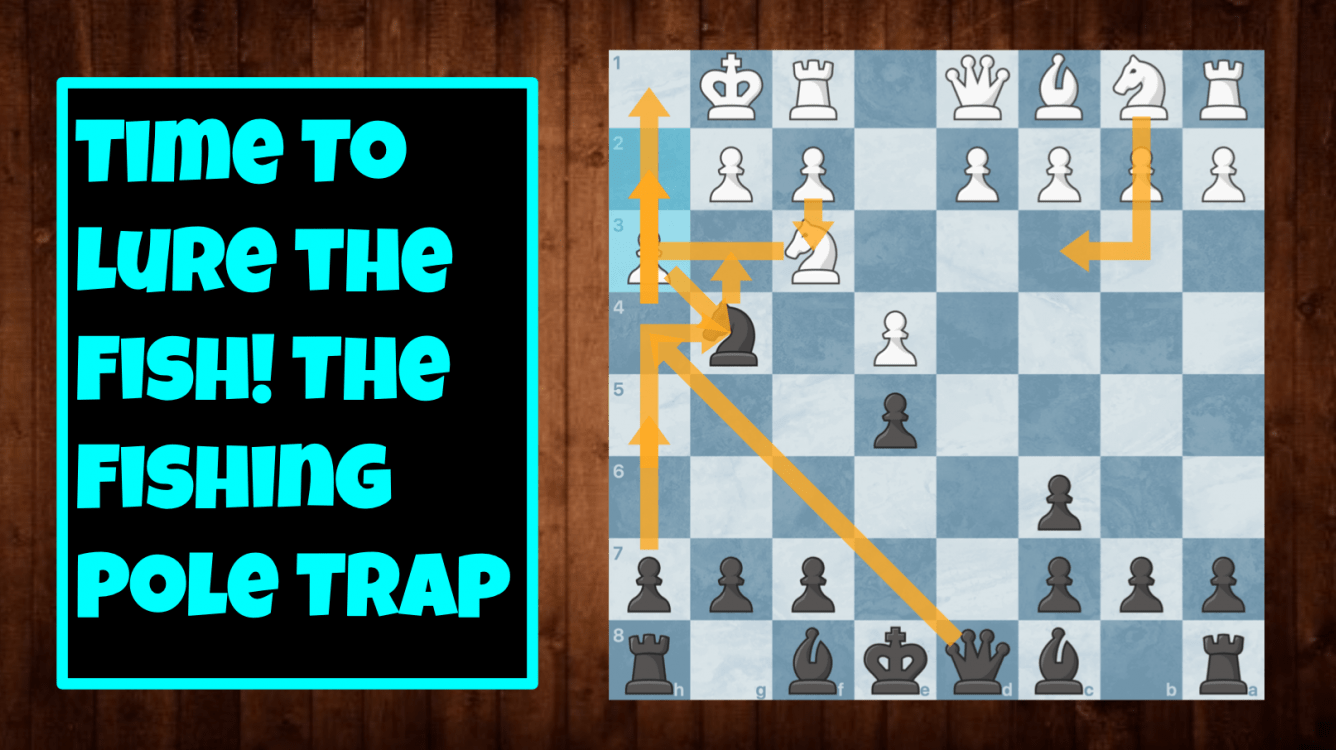
Time to lure the fish!! Fishing Pole Trap
Hey guys! This is @IAMDAGOAT123456789 and this is my 4th blog! A lot of people have been saying that Ive been doing a rather good job so Im going to continue my blog making.....Anyways this blog is about the Fishing Pole Trap and I really hope you enjoy it![]()
OVERVIEW
- Just like every other trap...this trap includes a sacrifice of one of their pieces either for a checkmate or a more valuable piece
- This trap derives from The famed Ruy Lopez opening
- And Lastly, this trap is for intermediate chess learners and enthusiasts..... and is also played for black
MOTIVES
- Sacrifices a knight for checkmate
- And even if the Trap fails you can still earn a MUCH better position for Black than white
Anyways, let's get started with the moves.....![]()
The First moves of the Fishing pole Trap are 1.e4, e5....this is a VERY common set of the first move and the motive of these moves are to gain control of the center....these moves allow for early development such as bringing out your knight to a controlling square and also opens up the bishop's diagonals early to eye down weak squares....heres a diagram
Next after the first move, white will play knight to F3 or 3.Nf3 to develop their knight and and to attack your pawn on D5....so after this you play knight to c6 or 2.Nc6 which both develops the knight and and attacks their pawn on e4.....here are the next two moves on a diagram....
After this....White will usually. castle for King protection as afterwards it'll be blacks turn who can just develop more pieces to weaken the white F2 square so black will usually castle in this case just for safety reasons....but if black doesn't castle then this trap does not work and will backfire so in order for this to be played white HAS to castle....look below
And after this....you play this rather weird move to white...knight to g4....this might not look like a great move as the knight can just easily be kicked away from that square by pushing the h3 pawn and it might look like black made a silly move and just lost tempo and time...but thats exactly what you want your opponent to think and play....here is the knight move
After this move, instead of pushing your knight back, you play h5 to back up this pawn. This is might seem like a HORRIBLE mistake or even a blunder as now white will be winning not only by position but by pieces as well and it might seem as black has lost it and has completely collapsed....here are the moves
And after white will most likely take seeing this a horrible move and quite possibly a blunder....
And after this move you obviously take back the pawn that took your knight or the knight you sacrificed.....after this move you are in fact attacking the knight now and since the player wants to most like say winning, they'll move their knight away for safety.....after all, thats what you would play if you didn't know this trap....
And so after this... you might notice that the rook has now an open file that lead straight to the king...which is what you use to help you gain this checkmate....as after you play this beautiful move, queen to h4 or Qh4....this a very powerful move and white should DEFINETELY be frightened now as they have very limited options.....
This is FOR SURE a very scary position for white.....but now they have a few moves to delay this checkmate.... lets start with the simplest...if white somehow sees no option to stop this checkmate, they could play a random move and then back will deliver checkmate...like this
Or....White can move the rook to the side and play Rook to e1 and this will only lead black to have one checkmate as opposed to 2 last time and it'll look like this....
But the absolute BEST option is to play pawn to h3...this move for white can delay checkmate and possibly black might not even see how it'll be mate in 2 or checkmate in 2 moves....Bur t here is how to play it.....
So this is the last type of way to finish off white if you are black....this trap consisted of sacrifces, bad positional, structures, and more but in the end it did lead to a checkmate.....
So lastly guys here are some Trivial Facts about this you might like to know
TRIVIA
- The Name Ruy Lopez is the name of a Spanish Priest
- discovered in 1490
- used most since the 20th century
So lastly, I really hope you liked this blog, it took me about 2 and a half hours and only used Wikipedia for the Trivia everything else I used was from previous knowledge so if you liked, dislike, think I forgot something....plz leave a comment below, and if you any traps I should do that I do not know about....plz PM (private message) me and ill se if I can do that![]()
Here are my other blogs check them out if you can![]()
https://www.chess.com/blog/IAMDAGOAT123456789/forks-and-pins-and-skewers
2nd,https://www.chess.com/blog/IAMDAGOAT123456789/fried-liver-attack-5
3rd https://www.chess.com/blog/IAMDAGOAT123456789/tennison-gambit?ncc=1#first_new_comment
Thanks and Regards,
@IAMDAGOAT123456789![]()